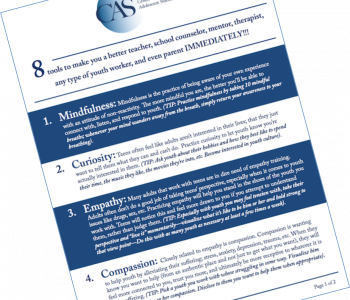

Sam Himelstein, PhD
Sam Himelstein is the founder and CEO of the Center for Adolescent Studies, Inc. He is passionate about working with youth and training the professionals that serve them.
4 Qualities That Lead to Interpersonal Connection and Safety with Youth
There are several ways to build rapport with youth, including the INCRA, deep listening, and skillful self-disclosure. It’s also imperative to work on those personal qualities that will contribute to our clients feeling interpersonally safe. These are less of what we “do” (interventions) and more of what we “are” (our presence, authenticity, compassion, etc.)
1) Attunement
Being attuned means both being present (to a client’s story, experiences, etc.) and having a strong presence (the energetic force that keeps you present and intentional). Attunement is the energetic metacommunication, “I’m with you. I see you. I hear you.” This is the type of presence that helps youth feel safe and trusting with you.
2) Authenticity
Authenticity is the art of being you. It means both being knowledgeable about yourself and showing up as that self in the moment. Authenticity is both an awareness and behavioral practice. It will help youth begin to trust you if you show up consistently and don’t try to act in a way you normally wouldn’t (that is, by using slang you don’t normally use, etc.)
3) Trauma-Informed Lens on Behavior Change
When working with youth who are resistant to treatment, which some trauma-impacted youth may be, it’s important to shift your stance away from immediate behavioral change as an indicator for treatment success. This of course doesn’t mean behavioral change isn’t important. It simply means that we recognize that resistant youth can become more rebellious if we force change talk. And for extremely traumatized youth, it means we don’t view their attempts and failures at using our techniques as a lack of success in therapy.
Our work is not to push them to change but to:
- build trusting relationships with them,
- help them gain perspective, meaning, and self-knowledge, and
- help them develop self-regulation capacities so that they can gradually switch from unhealthy coping mechanisms to healthier coping strategies.
4) Compassion
I’ve developed an acronym to help me practice compassion, especially with youth who’ve had horrendous trauma experiences and who may “act out.”
TAP stands for Take a breath, Acknowledge, and Proceed. I like the metaphor of tapping into my experience first before actually saying or doing anything.
“Take a breath” is a reminder to pause and become present. It’s the first step in skillfully responding to any tense situation, especially when working with trauma-impacted youth.
Next, the “acknowledge” has two parts. First, acknowledge how you feel or what your experience is. For example, I might feel tense, frustrated, overwhelmed, etc. when a youth in a group starts disrespecting another youth. I want to acknowledge that and be present to it, because only then can I make sure I don’t react to the situation in an unskillful way.
The second part of the “acknowledge” is where I activate my compassion. After acknowledging my own experience, I then acknowledge that this behavior, this resistance, could possibly be coming from a trauma response. When I do that, I can step out of my ego and explicitly send compassion toward the youth who’s acting out. It can be hard to do this, but it becomes easier with practice.
The final step of TAP is the “proceed” part. That’s when you actually say or do something to respond to the youth’s behavior or what they’re saying. Depending on the situation, you might express the compassion you feel towards them. Or you might need to gently set a boundary and remind them what behavior is and isn’t acceptable.
Concluding Thoughts
Fostering interpersonal safety is critical in practicing trauma-informed mindfulness. These four qualities are not an exhaustive list, but they are critical aspects of building a strong, trusting relationship with youth. They can also serve as a stepping stone to other interventions, like mindfulness, that can provide transformational change for struggling teens.
Join the FREE Resilience Community for Helping Professionals to learn more about trauma-informed care, resilience, mindfulness, building relationships, and more! Our community features self-paced courses, a monthly live Zoom call, a weekly live meditation, and an online platform to connect with other providers/professionals in your field.
Related Posts
Four Dos and Don’ts for Setting Effective Boundaries with Youth
How Can I Better Support Marginalized Youth?
How to Validate Teens (Even if You Don’t Agree)
6 Tips for Building Authentic Relationships with Adolescents

